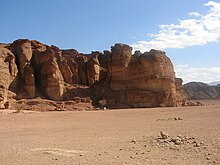 |
| cliff formations featuring "Solomon's Pillars", courtesy, Wikipedia |
It was the site of intensive copper mining and smelting activities
especially during the time of King Solomon. However, the mining site was considered
by most archaeologists to actually be earlier than the Solomonic period. The
discovery of numerous hieroglyphic inscriptions in Timna dating to the 14th–12th centuries
BCE now indicate that its copper industry, and probably of most of the other
copper-producing sites in the Arabah, was developed by Egyptian mining expeditions
during the 19th and 20th Dynasties. Usually,
they would travel from Egypt by sea and then overland to the mining site. The
inscriptions were found inside an Egyptian
temple, and dedicated to the goddess Hathor and located at the foot of "Solomon's Pillars" in the
center of the mining and smelting area; it was probably the central sanctuary
of Timna. This temple was built in the reign of Seti I at the end of the 14th century
BCE. Numerous temple gifts, including a partly gilded copper snake, a neḥushtan of
Midianite origin, and finds in the smelting camp indicate that the Egyptians
operated the copper industry of Timna together with the Midianites, Kenites,
and, probably, the Amalekites from the central Negev, possessing metallurgical
traditions going back to prehistoric times, as reflected in Genesis 4:22. The
Egyptian temple and copper industry, built in the Arabah at a time close to the
Exodus, and the numerous objects found in the excavations contribute materially
to understanding the cultural and social relations between the tribes of Israel
at the time of Moses and the Midianites and Kenites, through the Midianite
priest Jethro, father-in-law and adviser to Moses. Gifts were also sent to the
temple by Ramses II, Merneptah, and Seti II. Nowadays, the mining site can be
identified with "Atika, the great copper mines," described in the
Papyrus Harris I dating to the time of Ramses III. The bay of Jazīrat Farʿun,
the only natural anchorage in the Gulf of Eilat, can be identified as an Egyptian
mining port before it became the shipyard of King Solomon.
An archaeological
excavation led by Erez Ben-Yosef of Tel Aviv University found evidence
indicating that this area was also being mined by Edomites, a group who the Bible says were
frequently at war with Israel. Afterward, mining was continued by the
Israelites and Nabataeans through
to the 1st and 2nd centuries CE during the Roman period.
Since the 19th
century, many explorations and excavations were carried out at the site, the
most well-known having taken place in 1932-34 by German explorer Fritz Frank
and American archaeologist Nelson Glueck who gave the mines the name “King
Solomon’s Copper Mines”, and from 1959, by Israeli archaeologist Benno Rothenberg.
The modern Timna Copper Works were opened in 1959 and produce copper
cement (with a content of approximately 80% pure copper) from sedimentary ores
mined in open pits and shafts over an area of approximately 8½ sq. mi. Nearly
all the employees of the Timna Works were residents of Eilat. The modern works
were first closed in 1976 owing to an economic crisis in the copper industry.
They were reopened in 1980 and then permanently closed in 1985.
In 2002,
42,000 dunams in Timna Valley were declared a
nature reserve, ending all mining activity within the reserve's area. It
was opened by the Jewish National Fund to share Rothenberg’s findings with the
public. There are around 20 different
walking trails and some roads in the park to lead visitors to the various
attractions. A life-size replica of the biblical tabernacle, a tent that God is said
to have instructed Moses to build in
order to have a transportable sanctuary during the Exodus from Egypt to the Holy Land, was constructed in recent
years. It does not use the materials described in the Bible. Gazelles and ibex still
roam the area, but an image of these animals with ostriches found on a high ridge of sand suggests that ostriches
once lived here, as well.
Other attractions include:
the archaeological antiquities of the Shrine of Hathor and the Chariot Rock Drawings; the natural
phenomenon of The Arches (natural
arches formed by erosion); Solomon's Pillars; The Mushroom (a mushroom-shaped rock that was carved by the natural
forces of humidity and wind); the multimedia "Mines of Times" shown in the new visitors' centers; and the Timna
Lake, an artificial lake designed for recreational activities. The
park is also used as the location for open-air concerts and cliff-climbing
events. Because it is not part of
the system of national parks in Israel,
there has been controversy over construction of hotels and a large tourist
reserve in the area.
In July
2011, the Israeli government approved the construction of an international
airport, the Ramon Airport, in the Timna Valley.
No comments:
Post a Comment